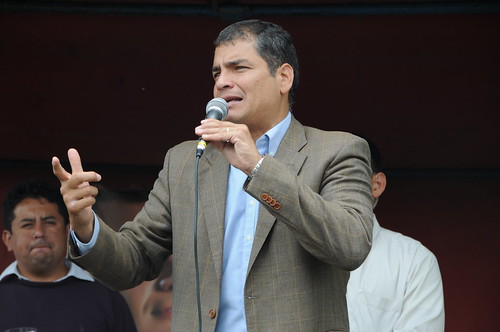
A recent Reuters article reports, “Correa has won broad popular support by expanding access to healthcare, doubling state spending on education and turning rough dirt paths into proper paved roads.” It also notes that, according to the government, Correa has “built 18 hospitals and 250 health centers across the nation.”
Indeed, Correa – who describes himself as “left-wing” – has made it a top priority to increase spending on social projects. Many believe Correa is on track to winning the upcoming election.
Yet, implementation of Correa’s health care plans has been slow. Like many other countries in Latin America, Ecuador’s health care system is taxed by overwhelming demand and a lack of resources. Since the country began providing free public health services in 2007, it has struggled to keep up with a growing body of patients; MEDLIFE staff members in Ecuador have often seen residents begin lining up hours before dawn in order to seek medical treatment.
The health system in Ecuador is comprised of a private and public sector, with the public sector guaranteeing, as stated in the revised 2008 Constitution, “permanent and timely access, without exception, to all comprehensive health care programs and services” for all citizens. However, overall, this covers the health care of only 51 percent of the Ecuadorian population, according to a June 2011 paper by the Ministry of Social Development in Quito, the nation’s capital.
The government funds 47 percent of outpatient and hospital services in the nation, in addition to the nation’s largest hospitals for referrals. But according to World Health Organization (WHO) standards, there should be between 8 and 10 hospital beds available per thousand people. The number of available beds in the Ecuadorian hospital system in 2011 was only 1.7 per thousand; many hospitals remain at full capacity.
MEDLIFE’s work in Ecuador has also changed under Correa. On the one hand, better government coverage of medical costs helps lift the financial burden on low-income families, as well as on MEDLIFE as an organization. On the other, quality is often poor and waits may be extremely long. A 2011 Wall Street Journal article said there were, at that time, “4,500 people on waiting lists for surgery.”
These problems are evident in this excerpt from a recent blog post written about a current MEDLIFE patient in Ecuador:
Jose’s first consultation for his condition was the entire family’s first visit to a hospital. It then took three months to schedule a surgery for him.
A nurse walks by and says the doctor has arrived at the hospital. He is the only pediatric surgeon, working four days a week, and it is obvious. Dozens of families rise to their feet at the news, standing around the exam room door, silently hovering in a semi-circle of anticipation. Eventually, people grow tired and sit back down.
When patients are referred within the public system for treatment, many times they still fail to receive the treatments they need due to lack of resources, lack of confidence, cultural insensitivity, or a lack of understanding about how to navigate the system. For all of these reasons, MEDLIFE’s role of advocating on behalf of our patients has become even more important.
You can read more about MEDLIFE’s patient follow-up process here.
